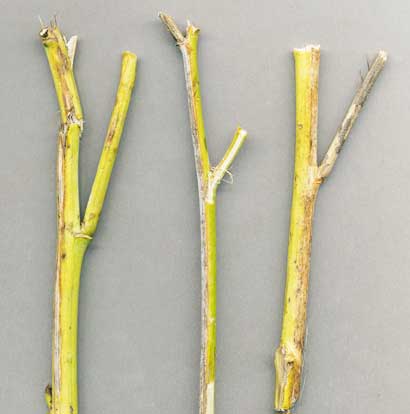New oilseed rape fungal disease spreading in UK

When verticillium wilt put in its first appearance in oilseed rape on a farm near Bourne in Lincolnshire last summer, Farmacy agronomist Richard Hartley was quick to identify the unfamiliar disease.
Brown and grey streaks all the way down one side of the stem (pictured, left), together with side branches turning opaque and early pod shatter, told him all he needed to know. The resulting 10% yield loss, from an estimated 70% infection, wasn’t as bad as he feared.
“This farm had average yields of 5.2t/ha last year,” he recalls. “We pay close attention to the timing of inputs, so we knew that the symptoms we were seeing couldn’t be due to phoma.
“The most surprising thing about this disease is that it doesn’t really show up until you are about to harvest the crop. In this case, it was at swathing time.”
It colonises the plant’s root system in the autumn after drilling – from soil-borne resting spores – but only moves into the plant during stem extension, he explains. “So it’s at maturity that it becomes obvious.”
There isn’t a great deal known about verticillium wilt, which was only confirmed on winter oilseed rape in the UK three years ago. But despite the lack of information on its distribution and frequency, many believe it is widespread in the south and spreading northwards.
As a result, a two-year HGCA-funded project is now under way, with Peter Gladders of ADAS at the helm. The project aims to get a better understanding of the impact of the disease, as well as investigating any varietal differences in tolerance.
“Verticillium wilt certainly appears to be spreading, but we’re less clear about how damaging it is,” says Dr Gladders. “Low infection levels may not be an issue.”
Already a significant problem in other parts of northern Europe, yield losses of 50% have been recorded in Sweden, he reports. “Short rotations were a contributing factor there, so it would be sensible to avoid growing oilseed rape more frequently than once every four years.”
Early drilling also seems to work in the disease’s favour, he notes. “That’s because the resting spores have more time to germinate and infect the roots. Club root needs a minimum temperature of 16C to get into plants and verticillium wilt could behave in a similar way.”
The disease is always more severe in hot, dry conditions. “It causes premature ripening and that is exaggerated in a drought situation. Yield losses may rise if summers get drier and warmer, as predicted.”
Developing a soil test is another future aim, he says. “The spores can survive as an infection source for 10 years, so having a quick and easy way of determining whether fields are contaminated would be useful. Thresholds could then be applied.”
Dr Gladders is working in conjunction with Farmacy on variety trials, with both parties hoping that partial resistance to verticillium wilt already exists.
Conventional varieties Castille and Kalif are susceptible, reports Hutchinsons‘ seeds manager Colin Button, so they are being grown as standards.
“It’s early days, but Catana and DK Exmen seem to have some tolerance to verticillium wilt,” he notes. “That could take on greater importance as the disease spreads; there are no fungicides.”
Breeder knowledge is limited and there’s no information included on the HGCA Recommended List, adds Mr Button. “Ratings for verticillium wilt resistance would be a good addition to the list and something that growers would value.”
Seed treatments may have a role, even though the disease isn’t spread by seed infection. “Moving contaminated soil or plant debris should be avoided, as well as using farm-saved seed where there’s been infection. It blows with the dust.”
For this year, Mr Hartley advised his client to drill at the end of August, rather than the middle, and to avoid a very tight rotation. But the presence of the disease on a neighbouring farm, which has only been growing oilseed rape for two years, indicates that it could be well established in the region.
“There are claims that using azoxystrobin as the first sclerotinia spray will also have some activity on verticillium wilt,” he says. “We need to do some work on that, to see if it’s right.”
The Pathogen
The fungus concerned, Verticillium longisporum, is different from the one which infects potatoes.
Its host range is brassicas and closely related weeds, such as charlock, but other weeds and crops may also act as hosts.
Current UK strains are thought to be the same as those found on oilseed rape in other parts of Europe and are likely to have been introduced on the seed.

